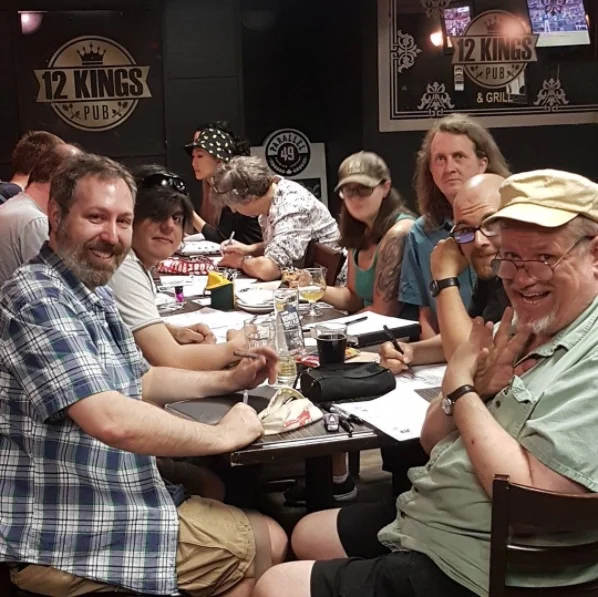
There are about ten people lurking in the corner of 12 Kings Pub, a no-nonsense sports bar on Kingsway just off Main. Each one has a sheet of paper, on which they draw one panel of a comic strip. When they’re done, they swap sheets, so that the next person continues the comic in the next panel, and so forth.
The result is a lot of non-sequiturs, surreal humour and clashing art styles. But according to the artists, that’s what makes it fun.
“I’ve tried lots of different styles, learned new techniques,” said Jeff Ellis, “It’s nice to exercise your art without a lot of judgement.”
This is what attracts artists to the Vancouver Comic Jam. It takes place at the 12 Kings on the third weekend of every month and is open to artists of all abilities and levels of experience.
“We have a mix of talents that show up,” said Jason Turner, who’s been organizing the events since 2012. “Sometimes there are about two dozen people here.”
Comic jams are pretty common worldwide. Vancouver’s group was started back in 2005 and has comprised of a dynamic, shifting cast of characters ever since. Amateurs mingle easily with professional artists like Ellis, the assistant director of Vancouver-based comic studio Cloudscape Comics, and Julian Lawrence, a professor at Emily Carr University. It’s a close-knit community where people can play off each other’s art in a relaxed and familiar way.
There’s a sort of intimacy here. Many say that this is where they come to break out of the isolation inherent in a career as an artist. It’s a regular thing they can look forward to and it forces them from an insulating world into an environment of communal creation.
“I’m in my head a lot,” said Klara Woldenga. The desire for a place where she can get out of her head and come interact with other artists is echoed by almost everyone present. The creation of comics is secondary to just enjoying time out with their peers.
None of them seem concerned if the stories turn out to be a mess. Some of the artists make an effort to tie their art style and their story ideas into the panel before them. Others go out of their way to make sure they’re as nonsensical as possible.
One sheet passes by with the first panel containing a massive foot coming down from the sky, with ominous text talking about the internet’s carbon footprint. The next panel is a man happily exclaiming, “I like having teeth!”
“The comics aren’t very serious,” said Turner. “Sometimes they’re specific to the night — we’ll be talking about something and someone will draw it in. It really reflects on who’s here.”
They follow their whims. Some of them like to draw differently than how they normally would. thers like to stick with what they know. Occasionally at the end of a comic that seemed to have gone completely off the rails the whole thing will be brought back around and make sense again.
The mixing — sometimes warring — of stories and styles speaks to how individual a pursuit comic drawing usually is. The weaving together of different comic communities, across different experience levels and generations, shows up on the page in wildly different perspectives and narrative goals. It’s a challenge that all are keen to tackle.
“This kind of art is about communicating,” says Colin Upton. “It’s not about hiding, or metaphors.”
Upton is a veteran of Vancouver’s comic scene. He was once hired by UBC Rare Books and Special Collections to compile local comics that represent the community’s efforts over the decades, since, in his words, “what’s more rare than small press?”
He’s not wrong — it’s surprising to learn that local anthologies and zines are still being printed at all. Most of the younger artists seem to focus their efforts online through art sharing sites, where they can have a more widespread impact.
“Its easier when you’re starting out to get noticed on DeviantArt or Redbubble,” said artist Matthew Nielsen. “You can find the people who are interested in the same stuff.”
Some insist that people still like physical comics and online followers aren’t as loyal, but that’s the expected generational bias. For most up-and-comers, the transition to primarily online work feels natural. There are even online comic jams now, which link artists across wider gulfs.
But those lack the impact and excitement of meeting in person, where sometimes the table is bustling with conversation and drink, and other times falls completely silent. The artists come out of their heads and fall back in again, bringing each other along for the ride.


![['']](https://storage.googleapis.com/ubyssey/media/renditions/comic_jam.original.jpg)
![['']](https://storage.googleapis.com/ubyssey/media/renditions/comic_jam_2.original.jpg)